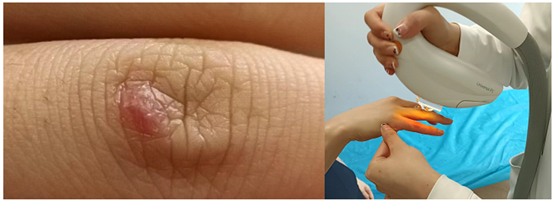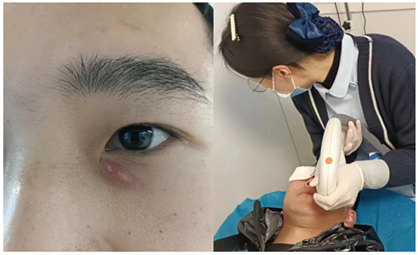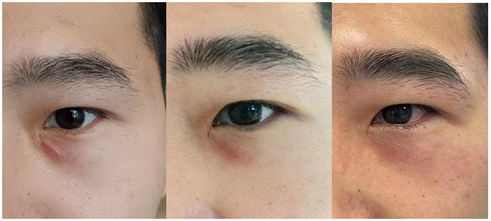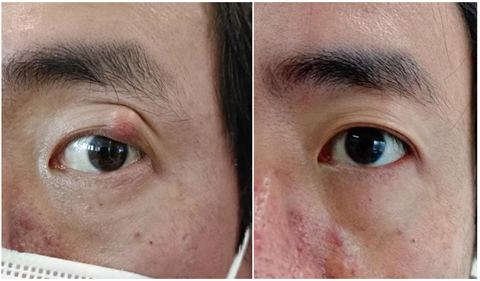
Hong Guan * , Hui Liu * , Huihui Xu, Yue Shen, Zihan Fan, Junjie ZhuanSun*
Hefei Bright Eye Hospital China.
*Corresponding author: Zhuan Sun Junjie, Hefei Bright Eye Hospital China.
Received: July 24, 2023
Accepted: July 27, 2023
Published: September 01, 2023
Citation: Hong Guan , Hui Liu , Huihui Xu, Yue Shen, Zihan Fan, Junjie ZhuanSun. (2023) “Clinical Observation of M22 in the Treatment of Inflammatory Granuloma.”. International Surgery Case Reports, 5(1); DOI: http;//doi.org/07.2023/1.1066.
Copyright: © 2023 Zhuan Sun Junjie. This is an open access article distributed under the Creative Commons Attribution License, which permits unrestricted use, distribution, and reproduction in any medium, provided the original work is properly cited.
Objective: To observe the clinical efficacy and safety of M22 in the treatment of inflammatory Granuloma.
Methods: Four patients with different inflammatory Granuloma treated with M22 in our hospital from January 2021 to December 2022 were observed and followed up. Among them, one case was local redness and swelling after skin scratch near the interphalangeal joint of the right ring finger, which continued to persist after drug treatment, one case was local Granuloma after eyelid trauma, one case was eyelid abscess, which had been treated for a long time after systemic infusion and anti-inflammatory, and one case was Meibomian gland cyst, whose mass still did not subside after incision through the eyelid conjunctival surface, All 4 patients were treated with local hot compress and systemic antibiotics, which were ineffective. Surgery was refused, and a 590 filter and three pulses were used, with energy starting from 10J. Later, the treatment gradually increased the energy, increasing by 1-2J each time. The treatment was performed 3-4 times with an interval of 2-3 weeks. After treatment, antibiotic eye ointment was applied locally to avoid high temperature and exposure to sunlight. The regression of Granuloma and the occurrence of adverse reactions were observed, and the therapeutic effect and complications were retrospectively analyzed.
Results: After the initial M22 treatment, the redness and swelling of Granuloma had improved. After the second treatment, the appearance of inflammatory Granuloma had basically subsided, and the local mass could still be touched. After the third to fourth treatment, there was no obvious trace, and the mass had not been touched. There was no recurrence during the follow-up of 3 to 6 months.
Conclusion: M22 has one more choice in the treatment of inflammatory Granuloma, which can avoid the scar caused by surgical incision, and does not need intravenous anesthesia and antibiotics infusion. It is a safe and non-invasive treatment, but the sample size is small, which belongs to the initial discussion. The long-term effect and safety need to be further observed.
Introduction
Inflammatory Granuloma is a nodular lesion formed by the proliferation of macrophages with a clear boundary. Infections of pathogens such as tuberculosis and syphilis can cause local inflammation, and then lead to inflammatory Granuloma. Inflammatory Granuloma often presents different symptoms in different locations, and larger inflammatory Granuloma may squeeze surrounding normal tissues, which needs timely treatment. Anti-inflammatory treatment and surgical treatment can be selected for treatment. Inflammatory Granuloma of the eyelid is mainly caused by poor gland secretion, plus inflammatory infection or/and improper treatment, such as secondary infection [1] after the collapse of Stye or Chalazion of the eyelid. Some patients are caused by infection spread of adjacent tissues of the eyelid. The eyelid tissue gradually forms Granuloma like inflammatory hyperplasia under the stimulation of foreign objects or inflammatory cells and other foreign objects [2]. If not treated in time, it may cause damage to the eyelid skin and scar formation, resulting in eye deformity, thus affecting the patient's appearance. The commonly used clinical treatment methods mainly include oral and injection of antibiotics, local medication and surgical treatment. At present, the most widely used and effective treatment method for ocular facial inflammatory Granuloma is surgical treatment [3], but most patients cannot accept it because of its invasive and scar formation. In the 1890s, some scholars tried to treat eyelid inflammatory Granuloma with immersion cold knife cryotherapy, and achieved satisfactory results [4-5], but no related reports were seen in the later period. There were other literature reports that glucocorticoid drugs [6, 7] and triamcinolone acetonide plus Hyaluronidase [8] were locally injected to treat eyelid inflammatory Granuloma with immersion cold knife cryotherapy, and achieved satisfactory results [4-5], but no related reports were seen in the later period. There were other literature reports that glucocorticoid drugs [6, 7] and triamcinolone acetonide plus Hyaluronidase [8] were locally injected to treat eyelid inflammatory Granuloma, and they had good therapeutic effects, and had the advantages of high efficiency, safety, and non-invasive, However, local injection still has the risk of needle fear, needle faintness and Drug allergy.
Intense pulse light (IPL) is a Pleochroism pulse light source released by high-energy xenon flash lamp under tens of thousands of volts of high pressure. It is composed of incoherent and non-parallel light with a wavelength of 400~1200nm. It was first used in the dermatology department to treat skin aging. In addition, it is also widely used to treat various pigmented, vascular and inflammatory skin diseases; Optimal Pulsed Technology (OPT) is the representative of the latest generation of IPL technology, which can more accurately control the time and energy of strong light emission, making it safer and more effective compared to previous generation technologies; As the representative of OPT, M22 forms broad spectrum light through focusing and filtering of high-intensity light source, and emits energy to eye tissues under the control of the instrument, effectively penetrating the skin, playing a precise targeting role. Its Photothermal effect closes small blood vessels around the Meibomian gland, blocks the release of inflammatory media, reduces the levels of inflammatory factors IL-17A and IL-6 in tears, reduces the level of PGE2, reduces inflammatory reactions, and helps kill bacteria and mites, Therefore, in recent years, it has been widely applied in the field of dry eyes and has achieved satisfactory results [9-10]. M22 has no risk of spreading inflammation caused by hot compress, so we try to use it to treat eyelid infectious diseases, and now it is reported as follows.

(Before treatment). (After the first M22 treatment).
Case 1 is a case of local redness and swelling in the right-hand ring finger near the interphalangeal joint, which persisted after 1 month of medication treatment. The redness and swelling area was tender (+) and faintly touched with a tough mass the size of mung beans. The patient attempted M22 treatment, using a 590 filter and three pulses, with a pulse width of 4.0 ms, a pulse delay time of 30 ms, an energy density of 10-18 j/cm2, and the initial energy started from 10 J. The energy size was adjusted based on the patient's skin and subjective feelings, each time increasing by 1-2J, the treatment was performed 3-4 times, with an interval of 2-3 weeks. After three treatments, the patient's local area has basically returned to normal.

(After the second M22 treatment) (After the third M22 treatment)
Case 2 was a local Granuloa formed after the trauma of the lower part of the nose of the left eyelid, with tenderness (-) and palpable cord like tough mass. After systemic infusion and local hot compress, the symptoms of redness and swelling did not subside. The patient refused to be removed surgically. After communication, he chose M22 for treatment. Also, 590 filter, triple pulse, pulse width of 4.0ms, pulse delay time of 35ms, initial energy density of 12j/cm2 were used. At the beginning and end, each time increased by 2J, three times, with an interval of two weeks, after three treatments, the patient's local area has basically returned to normal.

(Before treatment). (During treatment).

(First treatment). (Second treatment). (Third treatment).
Case 3 is an eyelid abscess that has been treated for a long time with systemic infusion and anti-inflammatory therapy. The patient refused surgery and chose M22 treatment. The patient also used a 590 filter and three pulses, with a pulse width of 4.0ms, a pulse delay time of 35ms, and an initial energy density of 14j/cm2. The initial and subsequent treatments increased by 1J each time, with an interval of 2-3 weeks. After three treatments, the patient's local area has basically returned to normal.

(Before treatment). (M22 treatment). (After three treatments).
Case 4 showed that the mass of Meibomian gland cyst still did not subside after incision of the eyelid conjunctival surface, refused to operate, and chose M22 for treatment. Also, 590 filter, triple pulse, pulse width of 4.0ms, pulse delay time of 35ms, initial energy density of 12j/cm2 were used. At the beginning and end, each time increased by 1J, and the treatment was performed four times, with an interval of 2-3 weeks. After four times of treatment, the patient had basically recovered to normal locally.

(Before treatment). (After four M22 treatments).
Discussion
Inflammatory Granuloma is a reactive and proliferative inflammatory disease caused by infection factors in the body. The infection factors can be microorganisms, drugs or other factors. Some scholars divide inflammatory Granuloma into specific inflammatory Granuloma and non-specific inflammatory Granuloma [11]. The specific inflammatory Granuloma is mostly tuberculous Granuloma. All cases in this group are non-specific Granuloma, the eyelid inflammatory Granuloma is a kind of special proliferative inflammation, which belongs to the fibrotic hyperplasia caused by chronic inflammation, and its main feature is the formation of Granuloma [12-13]. In 2011, foreign scholars reported for the first time a case of Granuloma in the eyelid after the treatment of frontofacial filling [14]. Some domestic scholars performed imaging examinations on eyelid Granuloma like tumors after the treatment of facial filling retrospectively, and observed that the size of the tumors did not change significantly after 6-12 months [15], which also showed that eyelid inflammatory Granuloma is usually difficult to subside or can recur, affecting the beauty of patients, However, conventional hot compress treatment is not effective, and patients need to take timely medication or surgical treatment, but there are certain risks, especially for some patients who are afraid of surgery.
As a new non-invasive Sex therapy, M22 can block abnormal blood vessels around Granuloma, block the release of inflammatory mediators, up regulate the expression of anti-inflammatory factors in local tissues, and down regulate the expression of proinflammatory factors,
Inhibit the activation of Matrix metalloproteinase, promote the balance of tissue microenvironment, and facilitate the regression of Granuloma. The common clinical complications are pain, erythema, edema, blisters, post inflammatory pigmentation, scab pigmented lesions, etc., the patients with severe color deposition can be treated by laser [16], while the rare complications are skin itching and Folliculitis, which may be related to light stimulation of local Sebaceous gland. Oral antihistamines, topical antibiotics and glucocorticoids can be used [17]. According to the above four cases of Granuloma in different parts and degrees, we used M22 to treat them, and three cases were around the eye, which was relatively risky, but none of them had eye or other complications. Yang Xiaoge et al. [18] also achieved satisfactory results by using intense pulsed light to treat children's Meibomian gland cysts, indicating that the treatment is safe, reliable, and the effect is ideal, but because of the cumulative effect of pulsed light treatment, the effect of single treatment is not ideal, Due to the need for multiple treatment intervals [19-20], the entire treatment cycle is relatively long. It is necessary to communicate with the patient and cooperate with the treatment. The treatment energy, pulse delay time, and pulse width are also being further explored. It is expected that in the future, a single treatment can achieve ideal results similar to surgery.
To sum up, the use of M22 optimized pulsed light in the treatment of inflammatory Granuloma is a non-invasive Sex therapy with obvious effect, which can be tried in ophthalmology and other clinical departments.